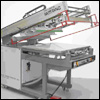Printing Industry
Industry Segments
The printing industry can be separated into four main segments and each must comply with all of the general industry standards (29 CFR 1910).

Lithography is a planographic printing system where the image and non-image areas are chemically differentiated with the image area being oil receptive and non-image area water receptive. Ink film from the lithographic plate is transferred to an intermediary surface called a blanket, which, in turn, transfers the ink film to the substrate. Fountain solution is applied to maintain the hydrophilic properties of the non-image area. Ink drying is divided into heatset and non-heatset. Substrate can be fed into the press either as individual sheets or from a continuous roll or web.
Frequently Cited Standards
OSHA maintains a listing of the most frequently cited standards for specified 6-digit North American Industry Classification System (NAICS) codes. Please refer to OSHA's Frequently Cited OSHA Standards page for additional information. For Lithography use NAICS code 322212, 322213, 323110, 323116, 323117, 323118, 51111, or 511191 in the NAICS search box.
NAICS Codes

Flexography routinely prints jobs that we all have contact with on a daily basis in the supermarket, at the warehouse store, at the shopping mall, and local newsstands. This printing process uses a flexible printing plate with a raised image mounted on a rotary cylinder. The liquid and fast-drying ink is applied to the printing plate by way of a finely engraved rotary cylinder, called an anilox roll. A flexo press is equipped with one to twelve color stations and can print on virtually any type of substrate, from corrugated board to flexible plastic film or textiles and cloth fabrics.
Frequently Cited Standards
OSHA maintains a listing of the most frequently cited standards for specified 6-digit North American Industry Classification System (NAICS) codes. Please refer to OSHA's Frequently Cited OSHA Standards page for additional information. For Commercial Flexographic Printing use NAICS code 323112 in the NAICS search box.
NAICS Codes

Gravure is an intaglio printing process. Gravure is the simplest of the major printing processes in terms of the number of ink transfers and moving parts. An image carrier has the image cut or etched below the surface of the non-image area. On the gravure image carrier all the images are screened, creating thousands of tiny cells. During printing, the image carrier is immersed in fluid ink. As the image carrier rotates, ink fills the tiny cells that cover the surface of the cylinder. The surface of the cylinder is wiped with a doctor blade, leaving the non-image area clean while ink remains in the recessed cells. Substrate is brought into contact with the image carrier with the help of an impression roll. At the point of contact, ink is drawn out of the cells onto the substrate by capillary action and transferred (printed) on the substrate. The substrate is passed through a dryer where the ink is dried.
Frequently Cited Standards
OSHA maintains a listing of the most frequently cited standards for specified 6-digit North American Industry Classification System (NAICS) codes. Please refer to OSHA's Frequently Cited OSHA Standards page for additional information. For Commercial Printing (except Screen and Books) use NAICS code 323111 in the NAICS search box.
NAICS Codes

Screen printing is a printing process in which printing ink, coating, or adhesive material is passed through a taut web or fabric to which a refined form of stencil has been applied. The stencil openings determine the form and dimensions of the imprint.
Frequently Cited Standards
OSHA maintains a listing of the most frequently cited standards for specified 6-digit North American Industry Classification System (NAICS) codes. Please refer to OSHA's Frequently Cited OSHA Standards page for additional information. For Commercial Screen Printing use NAICS code 323113 in the NAICS search box.
NAICS Codes

